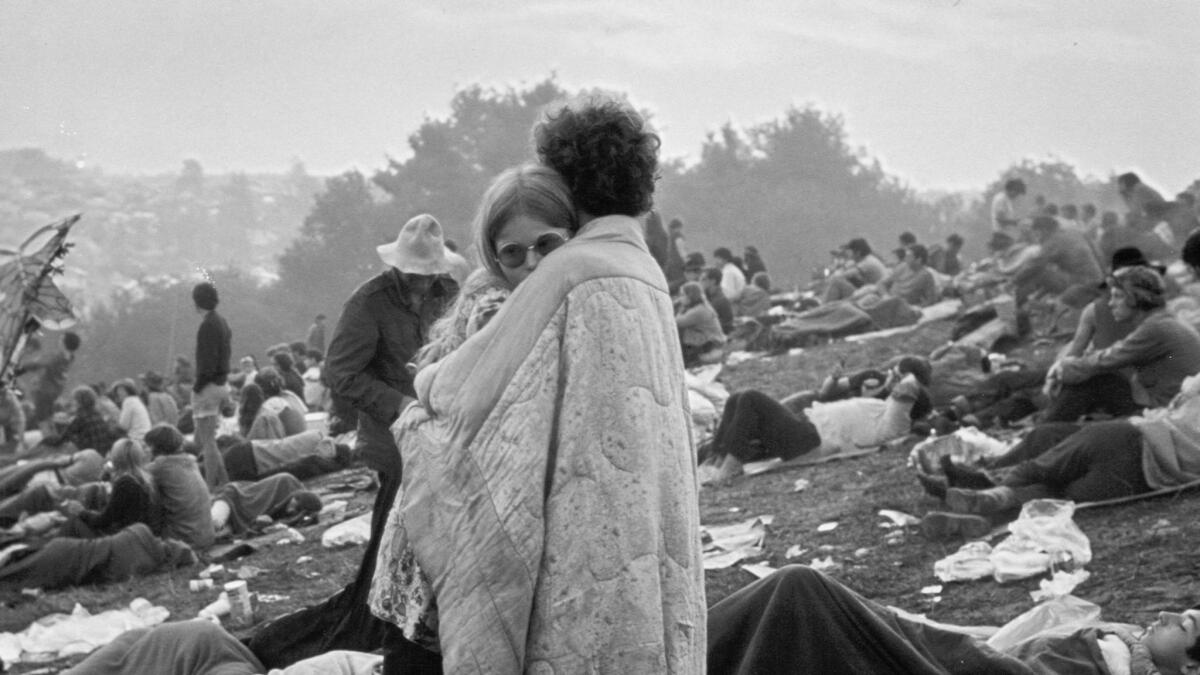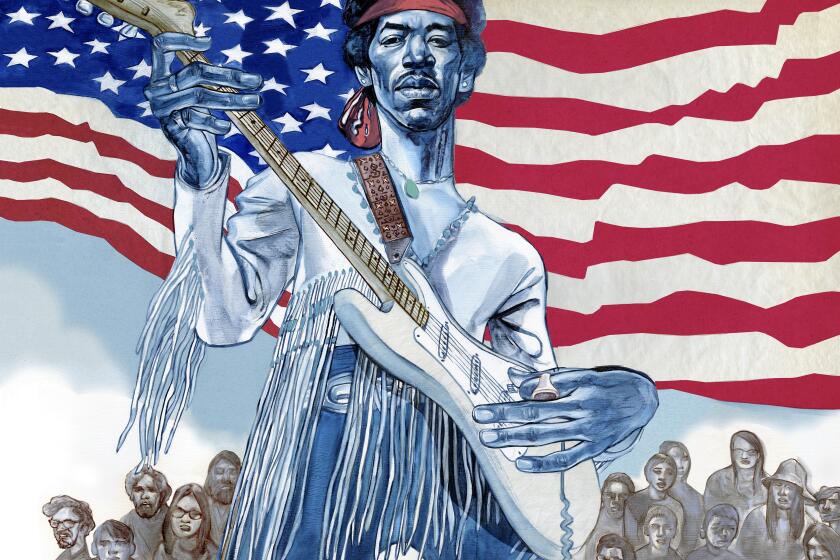How to relive Woodstock: What to listen to, watch and read this week

- Share via
When organizers of the Woodstock Music & Art Fair settled on the slogan “3 days of peace & music,” few could have known that a more apt tag line would have added “... and 50 years of bragging about it.” Considered by a certain generation its pinnacle cultural achievement, the experience of 72 hours on Max Yasgur’s farm in Bethel, N.Y., in August 1969 has generated as many hours of glorified content as there were LSD trips on the grounds — or at least it seems that way.
But if you’re willing to look beyond the baby-boomer propaganda, Woodstock as an event was still a visual and aural feast that drew not just a generation of spirited young rebels but also ascendant artists, photographers, writers, filmmakers and sound guys.
The bill made legends out of many: Janis Joplin, the Grateful Dead, Jimi Hendrix, Sly & the Family Stone and the Who, among them.
On the eve of Woodstock’s 50th anniversary, attendee Robert Christgau revisits one of the most galvanizing moments in rock history.
That the first Woodstock was well-documented wasn’t a foregone conclusion. Portable video cameras weren’t yet common, to say nothing of smartphones, but Woodstock promoters had arranged for filmmakers to document performances on 16 mm color film. They hired some of the best rock photographers to capture the scene and the vibe. They knew to get all the performances onto high-quality tape, and they booked sound engineers Eddie Kramer and Lee Osborne to record them.
With the freaks, stoners, rockers, folkies and groovers of America (and the grandchildren who love them) once again celebrating Woodstock — the mud, love, pot, brown acid, granola, community, nakedness and music — here are some of the best recordings, films and books that came out of those three days and nights.
WHAT TO LISTEN TO
“Woodstock: Back to the Garden” (Rhino)
The definitive new 50th anniversary archive from the lauded archival imprint is the full, minute-by-minute recording of the Woodstock concert. Issued as a limited-edition 38-CD box set, the project was meticulously produced by archivist and writer Andy Zax and Rhino Entertainment’s Steve Woolard, with the transfers produced by Brian Kehew and Zax. Sourcing the original 8-track masters and back-up monitor recordings, the team worked to separate fact from fiction.
The result is nothing short of stunning. As Zax notes in an opening essay, some of the Woodstock myths have come to be understood as fact: “[I]f we’re still thinking and arguing and opining about the meaning of Woodstock after half a century, shouldn’t we at least have a set of baseline facts about what happened there?” By the end of that last disc, those facts are incontrovertible.
The set is available in a number of formats, including curated highlight collections on LP, CD and digital download. Those unable to procure the already-sold-out full set should get the blank Maxell cassettes ready. Starting Aug. 15 at exactly 5:07 p.m. Eastern time, Philadelphia noncommercial radio station WXPN (and wxpn.org) will present a 72-hour synchronized broadcast called “Woodstock — As It Happened — 50 Years On.” Tapping the “Back to the Garden” box, the station will play, to the minute, the entire roster of performances, as well as the bounty of between-set onstage announcements. You’ll need about three dozen XLII-90s.
“Woodstock: Music From the Original Motion Picture Soundtrack” (Cotillion used LP)
Woodstock’s investors lost money on the event — lack of perimeter fencing was one reason — but they eventually ended up in the black. In addition to a self-produced movie, promoters rushed a triple LP to market. The selections of songs from the Who, Joplin, John Sebastian and Crosby, Stills, Nash & Young are interspersed with some of those myth-making announcements about the brown acid and the pending rainstorm.
Another notable untruth: that all of the songs on the album were recorded at Woodstock. According to Zax, some tracks were sourced from entirely different concerts. The album sold a ton, and the proof is all over the vinyl collecting site Discogs. It currently lists the triple album for sale at $10. Looking for extra authenticity? Buy the double 8-track tape for $13.99.
Creedence Clearwater Revival, “Live at Woodstock” (Concord)
Yes, a bunch of acts had great gigs at Woodstock, but John Fogerty and band’s chunka-chunka workingman’s rock, as proved on this just-issued release, packed a particularly hard punch. “Proud Mary” is a communal singalong; “Bad Moon Rising” feels, in hindsight, like a portent. The band’s rendition of Screamin’ Jay Hawkins’ “I Put a Spell on You” is a wild, yowling thrill — and negates the notion that Woodstock was entirely peaceful.
WHAT TO WATCH
“Woodstock: The Movie” (Warner Bros.)
The official documentary, released a mere seven months after the event, is an impressionistic glimpse of the weekend as viewed through rose-colored lenses. Directed by Michael Wadleigh, the movie won the documentary feature Oscar in 1971. Its success helped set the festival’s narrative for the millions of Americans who didn’t get dirty at Yasgur’s farm, edited (in part by a young Martin Scorsese) to further the “peace and love” message.
A beautifully shot cinéma vérité collage of performances, interviews, on-the-grounds revelry and mud-sliding joy, the film mostly glosses over the festival’s bad trips, barefooted puncture wounds and haphazard production. By his demeanor in the film, the sanitation guy vacuuming hippie waste from the porta-johns could be picking daisies.
As writer Zax notes in the “Back to the Garden” set, “Wadleigh’s film tells a story of Woodstock, but it doesn’t tell the story.” The film does offer intimate access to the performances, including Sly & the Family Stone’s seminal set. An updated director’s cut goes further, adding about 90 additional minutes of full-song performance footage.
“American Experience: Woodstock” (PBS)
In its newest season, the long-running PBS documentary series offers an informative overview and history of the production, from its seeds as a would-be Woodstock, N.Y., recording studio concept that united the four partners, to an escape-for-the-weekend music and art festival inspired by the Monterey Pop Festival two years earlier.
Drawing from archival film footage and narrated by a cast of participants and attendees including Woodstock executive producer Michael Lang, singer-songwriter David Crosby and “security” chief Wavy Gravy of the Hog Farm commune, the episode offers a blow-by-blow accounting of those three days, as well as context on the era, such as the effect the Vietnam War had on the counterculture, and the stress and nationwide unrest following the assassinations of the Rev. Martin Luther King Jr. and Robert Kennedy.
WHAT TO READ
“The Road to Woodstock,” by Michael Lang with Holly George-Warren (HarperCollins)
It’s better to remember Lang as a strapping young bad boy on a motorcycle at Woodstock ’69 than in his recent capacity as a windmill-tilting septuagenarian making the news with his abandoned 50th anniversary festival. The visionary young promoter imagined the original event with three others, he writes in “The Road to Woodstock,” and pushed forward with noble determination to create a magical event.
Written in collaboration with music journalist George-Warren, the book offers the most illuminating account of the festival. “For me, Woodstock was a test of whether people of our generation really believed in one another and the world were were struggling to create,” Lang writes. “How would we do when we were in charge? Could we live as the peaceful community we envisioned? I’d hoped we could.”
“Woodstock Vision” by Elliott Landy (Backbeat)
Along with Laurel Canyon chronicler Henry Diltz, photographer Landy shot Woodstock from the stage and captured now iconic images of performers including Joplin, Grace Slick, Joe Cocker and Richie Havens. At the time, the photographer was staying in the town of Woodstock and documenting Bob Dylan and the Band’s work. The first part of “Woodstock Vision” showcases those photos; the second focuses solely on the festival. Most striking are Landy’s images of the Woodstock crowd as seen from the stage: Each of the thousands of faces gazing back represents a different adventure, another world-shaking epiphany.
More to Read
The biggest entertainment stories
Get our big stories about Hollywood, film, television, music, arts, culture and more right in your inbox as soon as they publish.
You may occasionally receive promotional content from the Los Angeles Times.











